Evaporative Cooling Pad System Water Usage
Published: September 15, 2017
By: Michael Czarick 1, Brian Fairchild 2.
/ 1 Extension Engineer, University of Georgia; 2 Extension Poultry Scientist, University of Georgia.
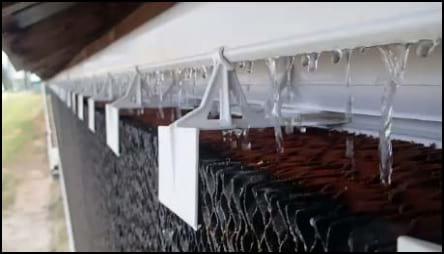
Knowing how much water an evaporative cooling system will use during hot weather can prove to be a very useful piece of information. For instance, to properly size well pumps, pressure tanks and water distribution pipes, designers must know the peak demand of pad systems on the farm because they can be responsible for 90% of the water usage on a hot summer afternoon. Furthermore, if a producer wants to install a water treatment system on their farm they must know what the peak water usage is to ensure the system is properly sized. Though knowing peak demand is important, knowing how much water the pads will use on a typical afternoon can also prove useful, especially if the farm is being supplied by municipal water system where the producer is being charged for every gallon of water used.
The amount of water the evaporative cooling pads will use is primarily dependent upon three factors: outside temperature, outside humidity and the amount of air being drawn through the evaporative cooling pads. The amount of evaporative cooling pad on a house, within reason, has a minimal effect on water usage. For instance, increasing pad area by 20% over what is typically recommended (1 ft2 per 350 cfm of tunnel fan capacity) will increase water usage by less than 5%. While in contrast, increasing the number of tunnel fans operating on a hot summer day 20% will increase pad water usage by 20%.
The amount of water a pad system will use over the course of the day will change as both outside conditions (Figure 1) and the number of exhaust fans operating change. As outside temperature increases, relative humidity will decrease and the amount of water evaporating off the pads will increase (Figure 2). In addition, the number of fans operating will tend to increase as outside temperatures increase, which further increases the amount of water evaporating from a pad system. For example, the evaporative cooling pads might only use 1.5 gals/min (per 100,000 cfm of tunnel fan capacity) in the morning when it is 85°F and 65% humidity, but in the afternoon this could increase to 2.6 gals/min (per 100,000 cfm of tunnel fan capacity) when the outside temperature increases to 95°F and the humidity falls to 50% (Figure 1). If in the same house the number of tunnel fans operating increases by 30% from morning to afternoon the water evaporating from a pad system can increase from 1.5 gals/min to 3.4 gals/min (per 100,000 cfm of tunnel fan capacity) from morning to afternoon. But, during very hot dry weather when temperatures climb above 100°F, and humidity falls well below 30% Rh, pad water usage can increase from 1.5 gals/min to 7 gals/min (per 100,000 cfm of tunnel fan capacity) from morning to afternoon.

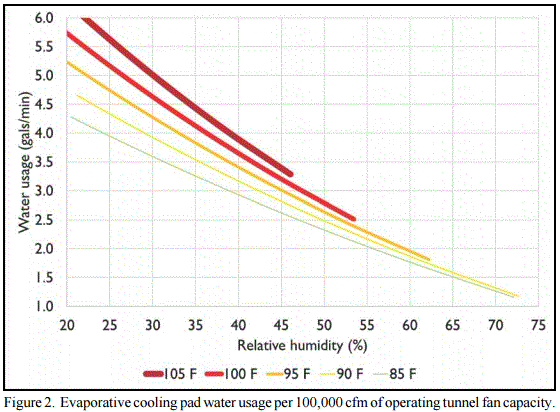
Though Figure 1 illustrates a typical summer day the fact is outside conditions will vary from day to day, week to week and year to year and as a result so will the cooling produced and water consumed by a house’s evaporative cooling system. Figure 3 was created using ten years (2007 - 2017) of hourly weather data for Athens, Georgia. The chart illustrates the range of relative humidities that existed when the outside air temperature was 80°F and higher. For instance, over the ten-year period when it was 90°F outside relative humidity ranged from a low 20% to a high of 65%. The variation in relative humidity would result in a variation in the cooling produced by a pad system at 80°F ranging of a low of 8°F when the relative humidity is 65% and a maximum of 20°F when the relative humidity was 20% (Figure 4). At higher temperatures, ie. 100°F, the outside relative humidity tended to be lower as was the variation in humidity (20% to 35% - Figure 3). The combination of the higher temperatures and generally lower humidities resulted in an increase in cooling ranging between 16°F and 21°F (Figure 4). Large variations in the amount of cooling produced by an evaporative cooling pad system would, of course, result in large variations in pad water usage.
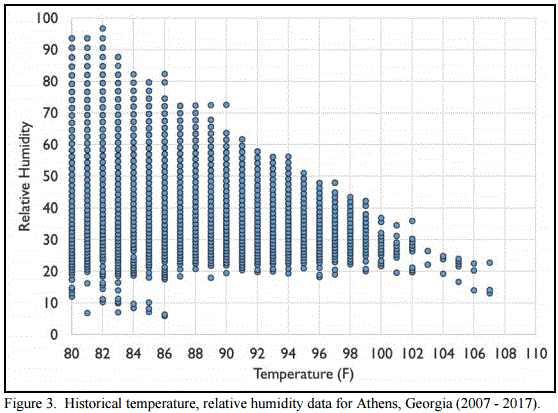
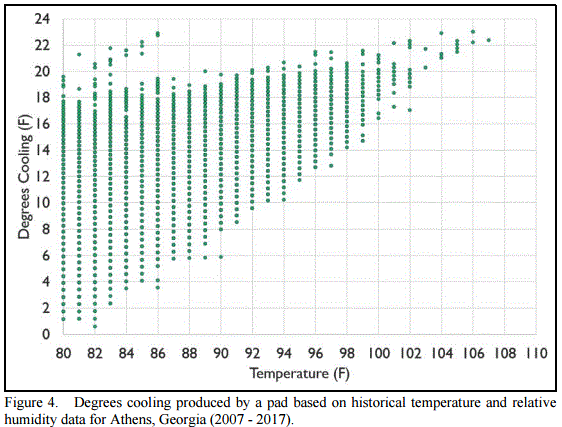
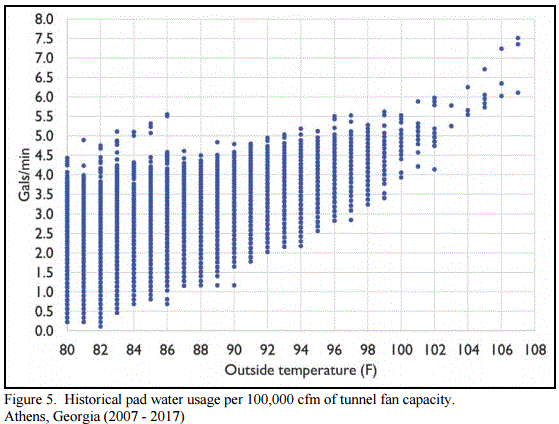
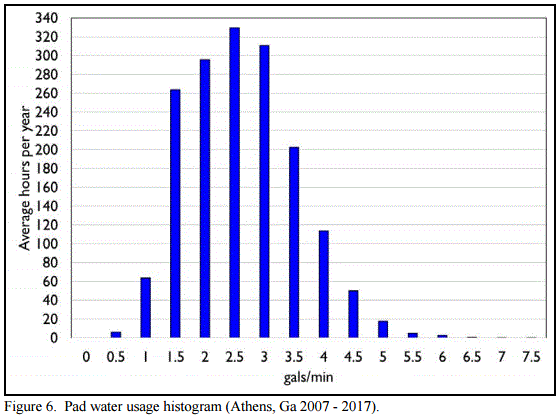
Figure 5 illustrates the expected water usage of a pad system, per 100,000 cfm of operating tunnel fan capacity, based on the same historical weather data illustrated in Figure 3 (Athens, Georgia 2007 - 2017). From this chart, we can see that at an outside air temperature of 90°F pad water usage varies between 1.5 to 4.5 gals/min. If outside temperature increases to 100°F we can expect water usage to vary between 3.5 to 5.5 gals/min. For a tunnel-ventilated house with 250,000 cfm of tunnel fan capacity this means that the pads typically use between 8.75 (3.5 gals/min X 2.5) and 13.75 gals/min (5.5 gals/min X 2.5) when it is 100°F outside and 3.75 and 11.25 gals/min when it is 90°F outside.
From Figure 5 it becomes clear that when outside air temperatures are 80°F or higher the potential water usage of a pad system can vary dramatically from a low of approximately 0.5 gals/min to high of 7.5 gals/min (per 100,000 cfm of tunnel fan capacity). But what isn’t clear from Figure 5 is what is typical pad water usage. Yes, the pads can use between 0.5 and 7.5 gals/min but how common are these water usage rates and what would be an average/typical water evaporation rate? For that, there is Figure 6. Figure 6 is a histogram of pad water usage (gals/min per 100,000 cfm of tunnel fan capacity) that illustrates the theoretical number of hours each summer a producer would expect various water evaporation rates from their pad systems. Figure 6 assumes the pads are operating all summer long whenever the outside temperature is above 80°F, which of course would be the worst case scenario. In most instances, the birds are not present in a house the entire summer or the birds are too young to require evaporative cooling and/or the evaporative cooling system may not be operated until the outside/house temperature is much higher than 80°F. The most important aspect of Figure 6 is not precise number of hours indicated but rather the relative frequency of the various water evaporation rates shown. For instance, though pad water can vary between 0.5 and 7.5 gals/min (per 100,000 cfm of tunnel fan capacity) the fact is the vast majority of the time it ranges between 1.5 and 4 gals/min with an average of approximately 2.5 gals/min. Furthermore, it illustrates how rare the peak water usage rates are. Yes, the peak water usage would be approximately 7 gals/min, but it only occurs a couple of hours each year. The more typical maximum pad system water usage rate would be closer to 4 to 5 gals/min at around 50 hours per year.
How much does an evaporative cooling pad water usage profile vary from location to location? Not as much as you may think. For instance, there are minimal differences in the both the peak and the average pad water usage for various poultry growing areas around Georgia (Figure 7). The most significant difference between the profiles is, as you might expect, that the total number of hours of operation is higher in the southern areas of the state where temperatures tend to be higher. Even when you compare most major poultry growing areas across the U.S. pad water usage profiles tend to be similar in shape (Figures 7 - 11). The most notable differences in water usage profiles are for the far western and northern states (Figure 12).
In California, water usage will tend to be dramatically higher than most poultry growing areas due to very hot and dry summertime conditions. In Minnesota, though the shape of the profile is similar to other regions, evaporative cooling pad water usage will tend to be very low because of the relatively low summertime temperatures.
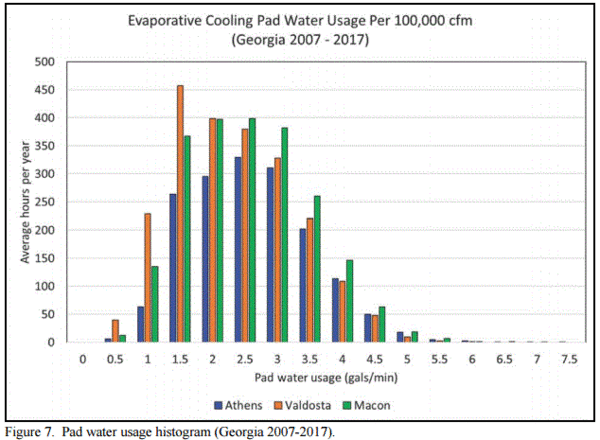
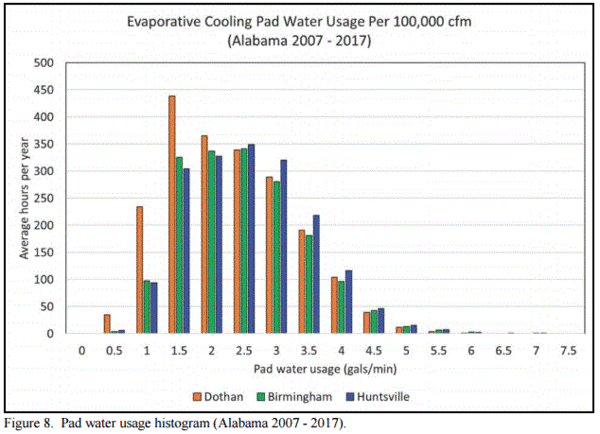

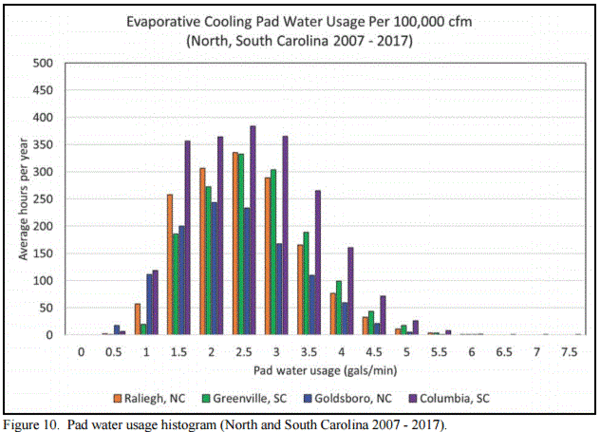
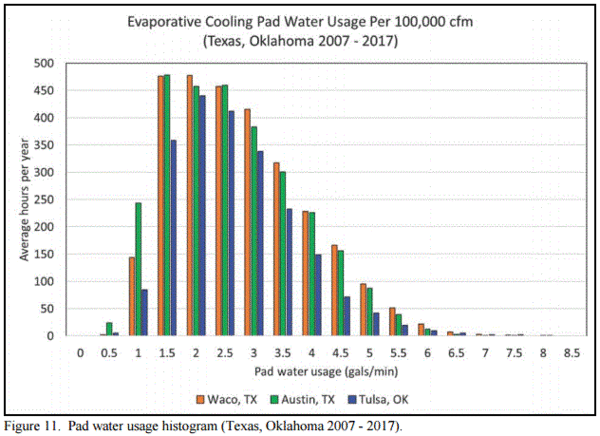

This article was originally published in Poultry Housing Tips, Volume 29, Number 1, College of Agricultural and Environmental Sciences Cooperative Extension, University of Georgia.
Related topics:
Authors:


Recommend
Comment
Share
27 de septiembre de 2017
Dr. Mike thanks for sharing every informative article. What you think thickness of pad to be used in temperate tropical areas, where in summer peak ambient temperature may goes to 40-42 C with RH 85-95% in July-August. Do you think by increasing thickness of pads will definitely increases surface area for evaporation. How one can determine pads area as thumb rule used for a fan having cfm 23000 for both 4" and 6" pads. If used 6" pad thickness we may need to have less pad area required due to more surface is available for evaporation vs 4" pads.
Recommend
Reply
30 de octubre de 2017
Dear Dr. can you estimate water supply in hot climate , same at Thailand , Philippines ?
Recommend
Reply
27 de septiembre de 2017
Dear Mates,
for those interested in getting farther information Please find the contact details of Eng. Nassar Al Madhoun the founder & MD of Masader .
Mobile 00966553443902
Nassar@arabengineers.co.uk
regards
Recommend
Reply
27 de septiembre de 2017
Dr. Mike thanks for sharing every informative article,
I have experience a newly invented pad material (Posalaious) where we can utilize the slot water for the cooling system it even can utilize the sea water for this purpose.
it is a product of Saudi designer (company called Masader in Jeddah KSA) who has a joint venture with king Abdullah university.
I believe such invention should be supported & tested.
Recommend
Reply
Recommend
Reply
Recommend
Reply
Recommend
Reply

Would you like to discuss another topic? Create a new post to engage with experts in the community.
Featured users in Poultry Industry

Shivaram Rao
Pilgrim´s
PhD Director Principal de Nutrición y Servicios Técnicos de Pilgrim’s Pride Corporation
United States
United States













